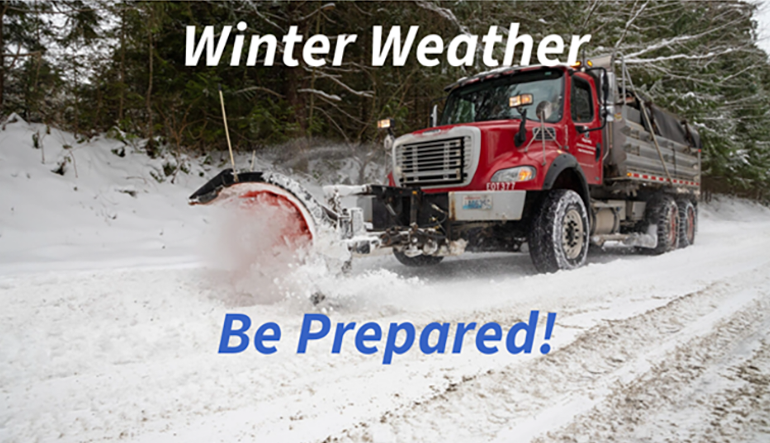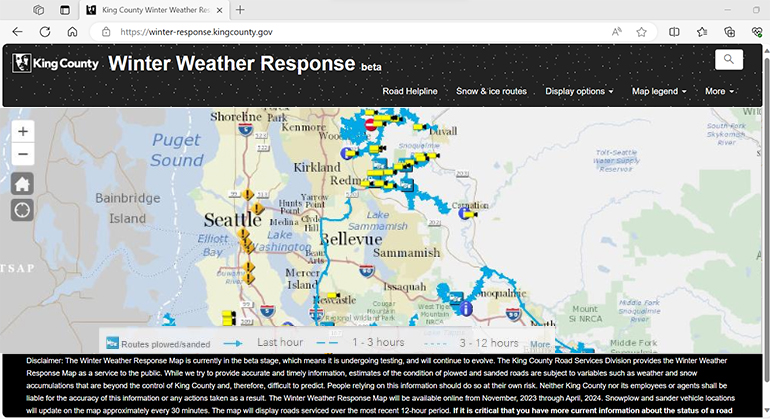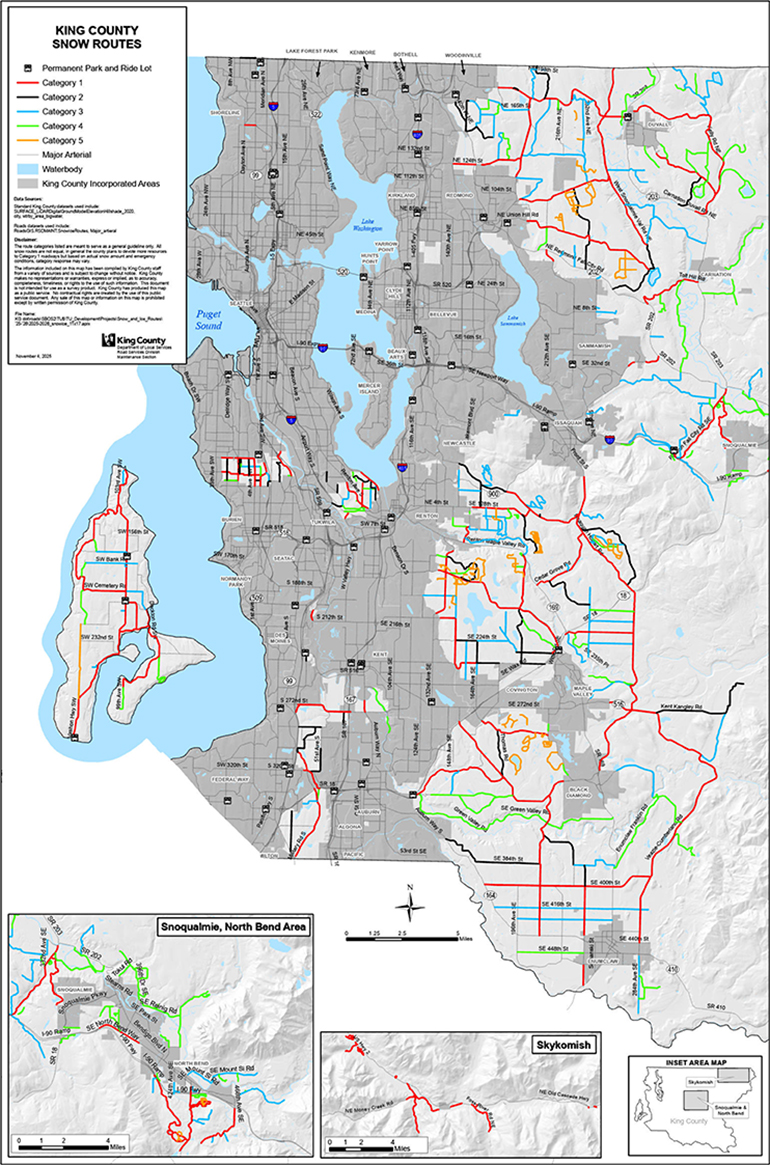Winter weather: Snow and ice in unincorporated King County
Winter Weather Response Map
When it snows, use the Winter Weather Response Map to find plowed and treated roads in unincorporated King County.
Check your snow route
Will your route be clear this winter?
Road Services plows and applies snow-melting treatment to 583 miles of designated snow and ice routes. During snowy weather, our main goal is to keep the major roads in unincorporated King County open for travel, and to ensure the safety of travelers and our dedicated crews. Our snow and ice routes are categorized and are plowed and treated in priority order.
Priority plow routes – Where we plow first
We prioritize clearing snow from the most heavily traveled roads:
- Life-safety routes, roads that lead to hospitals, fire stations and other emergency services
- Major thoroughfares and arterials
- Transit routes
- Roads that serve densely populated areas or connect communities
The routes are shown on the Snow Routes Map (786KB) as category 1 and 2. It could take up to three days or more to plow and treat the routes depending on how much snow we get or how icy the roads are.
Other plow routes
After the category 1 and 2 routes (786KB) are clear, we move on to plow snow and treat the remaining snow and ice routes.
Please be prepared for the possibility that you may need to stay home and avoid driving for up to several days during a major, countywide winter storm.
Snow may accumulate faster than our plows can keep up. Crews must continue to re-plow category 1 and 2 routes until they are all clear before moving on.
Emergency road plowing
If you have an urgent or life-threatening emergency and your road is not plowed, call 9-1-1. We collaborate with first responders to clear roads outside of our usual snow routes when instructed by 9-1-1.
Map of 2025-26 snow routes (786KB)
Be prepared!

Resources for emergency preparedness
The National Highway Traffic Safety Administration has a helpful list of winter weather driving tips found here. Washington State Department of Transportation has provided a couple of great documents – found here – to print or save to use during the winter months.
Emergency preparedness information from other agencies:
Winter weather frequently asked questions
Road Services partners with public safety officials to decide which roads are included in each snow and ice route. The selection process primarily considers the role each road plays – such as access to hospitals, connecting communities, facilitating bus routes, or serving as access points to highways. The snow and ice routes are prioritized. We start with category 1, then category 2 routes because they are most heavily relied upon by the largest number of people as well as those used by emergency responders.
There are 1500 miles of road in unincorporated King County. We make the best use of our limited resources by focusing on plowing and snow melting treatments on 583 miles of this road network.
- Lifeline emergency routes, routes to hospitals and other emergency services
- High-volume arterial roads that provide regional connections between communities and main highways
- Transit snow routes
Category 2 Roads:
- Main thoroughfares and roads that lead to densely populated areas and state highways
- Minor collector roads that serve densely populated areas
- Some category 2 routes may be delayed or not plowed and treated until all category 1 routes are fully clear.
Remaining Routes:
Category 3 Roads:
- Main roads that connect towns and large subdivisions with cities
- Roads connecting category 1 and category 2 routes.
- Residential roads in lower and upper elevations that connect neighborhoods to each other.
We do our best to clear designated snow and ice routes in priority order. Sometimes unforeseen issues arise that slow our progress. Some examples are:
- Snow accumulates faster than our plows can keep up with requiring us to re-plow category 1 routes until they are clear before moving on.
- The need to redirect crews off a snowplowing route to clear a fallen tree from a different road.
- Emergency responders ask us to clear other areas so that fire trucks and ambulances can respond to a 9-1-1 incident.
- Snow plowing may be delayed due to equipment breakdowns.
During an active winter storm, we cannot fulfill requests to plow roads within our designated snow and ice routes. The crews make every effort to clear category 1 and 2 routes and then move on to the next priority route.
Once category 1 and 2 routes are plowed and sustained, crews can move onto the next designated routes. When these routes are complete, they will move on to non-designated routes.
Please note: Snow may accumulate faster than our plows can keep up with. Crews will continue to re-plow category 1 routes until they are all clear before moving on to category 2 routes.
Please do not attempt to plow a county road.
Residents or contractors who plow a public road risk significant personal liability if someone is hurt or killed, or if property is damaged.
Ice can form sooner on bridge decks and overpasses before it does on the roadway. Air can circulate both above and below the surface of the elevated roadway, causing the pavement temperature to drop more rapidly. Ice can also form in shaded areas.
De-icing – is a reactive road treatment. Road Services applies granular salt on top of accumulated snow and ice that has already bonded to the road surface. This process is performed while also removing accumulations of snow with a truck mounted plow.
Experiencing:
- Life-Medical Emergency call 9-1-1.
- Roads blocked with trees, utility wires, or fallen ‘Stop’ signs, call our 24/7 Helpline at 206-477-8100.
- For non-emergencies you may email maint.roads@kingcounty.gov.
Roads and flooding
Flooding can occur after a heavy snowfall melts. Learn about flooding in unincorporated King County and our response.

 Translate
Translate

